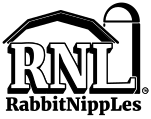
AZ Rabbits' rabbitry is at an off-site approved location. Make sure you are following local laws and regulations.
________________________________________________
New Zealand White rabbits (as well as other similar sized breeds) do best in all wire cages. You can either purchase your cages from a reputable manufacturer or build them yourselves. Wooden hutches require more cleaning and sanitizing and often result in breeding ground for disease and pests. Because of this, AZ Rabbits recommends you use strong and sturdy all wire hutches.
For the NZW sized rabbit breeds, cages should be approximately 36" wide, 30" deep and 18" high (minimum of 30"x30"x18") for the does and 30" wide, 30" deep and 18" high (minimum of 24"x30"x18") for the bucks. The floor should be 1/2" x 1" 14 gauge galvanized wire (galvanized AFTER weld is best) and the sides and top should be 1" x 2" 14 gauge galvanized wire.
The door opening should be at least 12" x 12", although bigger is nice. Doors swinging inward will keep the rabbits in just in case you forget to latch the door. Doors that open outward will allow you to more easily get inside the cage without pushing the rabbits aside. It all depends on your personal preference. At AZ Rabbits, we prefer cages that open out, hinged on the right side.
The cage can be secured using j-clips or c-rings. Both types have their unique benefits. j-clips don't have the sharp edges that c-rings do (which sometimes pull small amounts of hair off the rabbits) but they also collect more urine and gunk than the c-rings.
You also may want to consider getting "baby saver" walls. This is 1/2" x 1" wire along the bottom 4 to 6 inches of the walls (same wire as the floor). This will save litters from falling out of the cage onto the ground and dying when a new mother mistakenly has the litter outside the nest box. See image below for example of this wire.

There are some who market hutches with all kinds of "levels", rooms and other luxuries. These are marketing techniques from people who are more interested in making money than understanding the necessities of rabbits. Remember, even though this is coming from a meat production perspective, we still do all we can to ensure our rabbits are healthy and happy and encourage all breeders to do the same. But rabbits can be completely happy, healthy and productive in all wire hutches with the dimensions listed at the top of this page.
Also be careful about listening to those who would go in the opposite direction and market too small of cages. We've seen people raising rabbits in half the size that we (and most experts) recommend. Doing this will result in compromised health, less production and overall poorer results. Fitting more in smaller spaces does not necessarily result in higher production and profits. Do it right!

In the future you will be able to purchase hutches and hutch supplies directly from AZ Rabbits. Until then we're more than happy to make recommendations of trusted retailers.
____________________________________________________
Lighting
For optimal health and breeding, it is recommended you have 14 or more hours of light per day. During some parts of the year, artificial lighting may be required. This is more critical for the does than the bucks and will make a noticeable difference in production.
In order to do this, we recommend you get an automatic timer to eliminate the necessity to control the lighting by hand. It is a small investment with great returns.
____________________________________________________
Cleaning Cages
Keeping your cages clean is a very important part of maintaining good health and keeping ailments from spreading in your rabbitry. DO NOT pass on the required maintenance. Some of the items you'll need are:
- Stainless steel wire brush (or other wire brush)
- Clorox bleach (non-scented)
- Scrubbing pad / wire scrubbing pad
- Vanodine V-18 concentrate
- Spray bottles
- Rags, water bucket and other misc cleaning supplies...
Various tools are needed to keep your cages in their optimal conditions and disinfected. This information is a basic recommendation. Individual needs and situations will vary.
Cleaning cages should be done on a regular basis and recommended between litters to maximize sanitation. And there are deep cleanings and periodic sanitations. Deep cleanings require the rabbit to be removed from the cage. Periodic sanitations can be done with the rabbit inside.
Deep Cleaning
To deep clean a cage, first remove the rabbit. Put bleach water in a spray bottle and also in a bucket. Spray down the cage with the bleach water spray bottle (allows bleach water to get into all corners and crevices).
Use the wire brush to scrape off the hard build up areas (usually 1 or 2 spots on the back corner of cage where the rabbit usually urinates). If the scrubbing pad/wire scrubbing pad can be used, it is better and will keep the cage in optimal condition longer.
Then wipe down the entire cage with a rag that is dripping wet with bleach water (using bucket of bleach water). Be sure to get every corner, top, bottom, etc. Scrub the inside floor and under the floor particularly well. The bleach will not only clean, but sanitize, killing any bacteria, viruses, spores, etc.
Make sure you remove and deep clean the feeder as well. If you have an automatic watering system, clean and disinfect the nipple. If you have water bottles, you should be cleaning them all on a regular basis.
Let the cage dry. Fill the spray bottle with clean water and rinse out bucket and rag. Fill with clean water.
Next spray down cage with regular water with the spray bottle. Then wipe down entire cage with clean, wet rag. Be sure to use plenty of water in your wiping and get all corners. This will remove the bleach residue and leave you with a clean cage. If you don't remove the bleach, you will get a build up and shorten the life of you cage.
At this point, depending on the temperature and climate, you may want to dry off your cage. Wiping the cage dry gives you one more chance to look over all areas of the cage.
Periodic Sanitations
Periodically you'll want to sanitize your cages when you are between deep cleanings. Usually this can be done with the rabbit still inside. To do this, you'll want to use a wet rag (just using clean water) and wipe down all areas of the cage.
Next, use Vanodine V-18 diluted down in a spray bottle and spray down all areas of the cage. That's all there is to it! This will kill the bacteria, viruses and spores, leaving a sanitized cage.
*Don't forget to clean and sanitize your nest boxes between uses as well!
Fly Control
If the manure is allowed to get out of control or proper care not given to sanitation, you may experience fly problems. But there are some things you can do for basic fly management.
- Use agricultural lime to sprinkle generously over manure about twice a week, or as needed. The lime absorbs the moisture.
- When you stir up the manure and if you see maggots (young flies), spray with larvicides approved for poultry cage houses (always follow label directions and use proper ventilation).
- Use fly paper, traps, etc. placed throughout your rabbitry.
- Most importantly, clean out manure often. Elimination of manure is the easiest, most economical and effective way to control flies.
If flies begin to get out of control, use the above suggestions and purchase a fly swatter. Spend some time eliminating the flies and then let the above suggestions help you maintain low levels of flies. Common sense is key in prevention and control.


